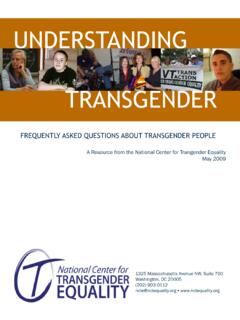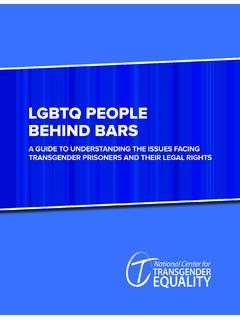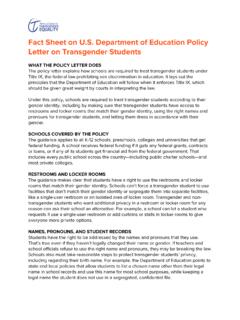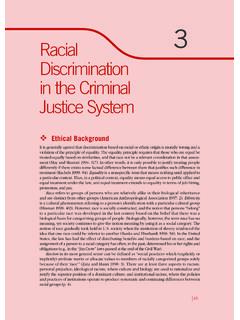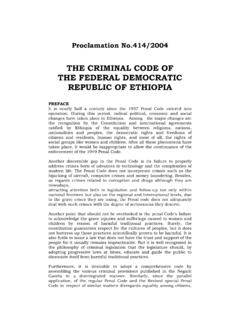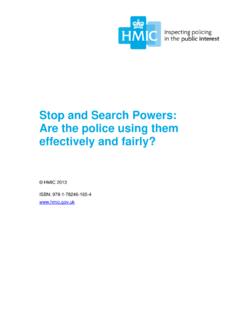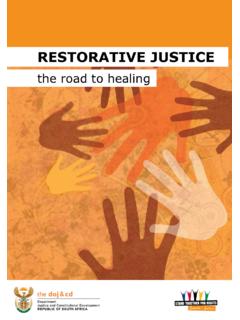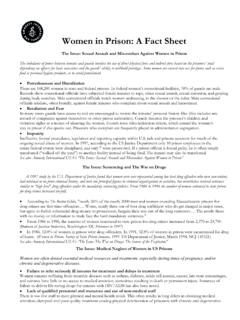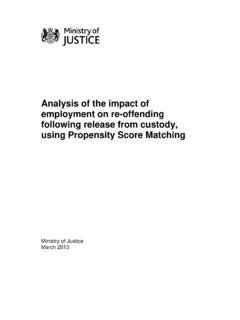Transcription of THE REPORT OF THE
1 December 2016 THE REPORT OF THE2015 TRANSGENDER SURVEY2 USTS Executive Summary The 2015 Transgender Survey (USTS) is the largest survey examining the experiences of transgender people in the United States, with 27,715 respondents from all fifty states, the District of Columbia, American Samoa, Guam, Puerto Rico, and military bases overseas. Conducted in the summer of 2015 by the National Center for Transgender Equality, the USTS was an anonymous, online survey for transgender adults (18 and older) in the United States, available in English and Spanish.
2 The USTS serves as a follow-up to the groundbreaking 2008 09 National Transgender discrimination Survey (NTDS), which helped to shift how the public and policymakers view the lives of transgender people and the challenges they face. The REPORT of the 2015 USTS provides a detailed look at the experiences of transgender people across a wide range of categories, such as education, employment, family life, health, housing, and interactions with the criminal justice system. The findings reveal disturbing patterns of mistreatment and discrimination and startling disparities between transgender people in the survey and the population when it comes to the most basic elements of life, such as finding a job, having a place to live, accessing medical care, and enjoying the support of family and community.
3 Survey respondents also experienced harassment and violence at alarmingly high rates. Several themes emerge from the thousands of data points presented in the full survey Mistreatment and ViolenceRespondents reported high levels of mistreatment, harassment, and violence in every aspect of life. One in ten (10%) of those who were out to their immediate family reported that a family member was violent towards them because they were transgender, and 8% were kicked out of the house because they were transgender. The majority of respondents who were out or perceived as transgender while in school (K 12) experienced some form of mistreatment, including being verbally harassed (54%), physically attacked (24%), and sexually assaulted (13%) because they were transgender.
4 Further, 17% experienced such severe mistreatment that they left a school as a result. In the year prior to completing the survey, 30% of respondents who had a job reported being fired, denied a promotion, or experiencing some other form of mistreatment in the workplace due to their gender identity or expression, such as being verbally harassed or physically or sexually assaulted at work. EXECUTIVE SUMMARY3In the year prior to completing the survey, 46% of respondents were verbally harassed and 9% were physically attacked because of being transgender.
5 During that same time period, 10% of respondents were sexually assaulted, and nearly half (47%) were sexually assaulted at some point in their lifetime. Severe Economic Hardship and InstabilityThe findings show large economic disparities between transgender people in the survey and the population. Nearly one-third (29%) of respondents were living in poverty, compared to 12% in the population. A major contributor to the high rate of poverty is likely respondents 15% unemployment rate three times higher than the unemployment rate in the population at the time of the survey (5%).
6 Respondents were also far less likely to own a home, with only 16% of respondents reporting homeownership, compared to 63% of the population. Even more concerning, nearly one-third (30%) of respondents have experienced homelessness at some point in their lifetime, and 12% reported experiencing homelessness in the year prior to completing the survey because they were transgender. Harmful Effects on Physical and Mental HealthThe findings paint a troubling picture of the impact of stigma and discrimination on the health of many transgender people.
7 A staggering 39% of respondents experienced serious psychological distress in the month prior to completing the survey, compared with only 5% of the population. Among the starkest findings is that 40% of respondents have attempted suicide in their lifetime nearly nine times the attempted suicide rate in the population ( ).Respondents also encountered high levels of mistreatment when seeking health care. In the year prior to completing the survey, one-third (33%) of those who saw a health care provider had at least one negative experience related to being transgender, such as being verbally harassed or refused treatment because of their gender identity.
8 Additionally, nearly one-quarter (23%) of respondents reported that they did not seek the health care they needed in the year prior to completing the survey due to fear of being mistreated as a transgender person, and 33% did not go to a health care provider when needed because they could not afford TRANSGENDER SURVEY4 The Compounding Impact of Other Forms of DiscriminationWhen respondents experiences are examined by race and ethnicity, a clear and disturbing pattern is revealed: transgender people of color experience deeper and broader patterns of discrimination than white respondents and the population.
9 While respondents in the USTS sample overall were more than twice as likely as the population to be living in poverty, people of color, including Latino/a (43%), American Indian (41%), multiracial (40%), and Black (38%) respondents, were more than three times as likely as the population (12%) to be living in poverty. The unemployment rate among transgender people of color (20%) was four times higher than the unemployment rate (5%). People of color also experienced greater health disparities. While of all respondents were living with HIV nearly five times the rate in the population ( ) the rate among Black respondents ( ) was substantially higher, and the rate for Black transgender women was a staggering 19%.
10 Undocumented respondents were also more likely to face severe economic hardship and violence than other respondents. In the year prior to completing the survey, nearly one-quarter (24%) of undocumented respondents were physically attacked. Additionally, one-half (50%) of undocumented respondents have experienced homelessness in their lifetime, and 68% have faced intimate partner with disabilities also faced higher rates of economic instability and mistreatment. Nearly one-quarter (24%) were unemployed, and 45% were living in poverty. Transgender people with disabilities were more likely to be currently experiencing serious psychological distress (59%) and more likely to have attempted suicide in their lifetime (54%).

